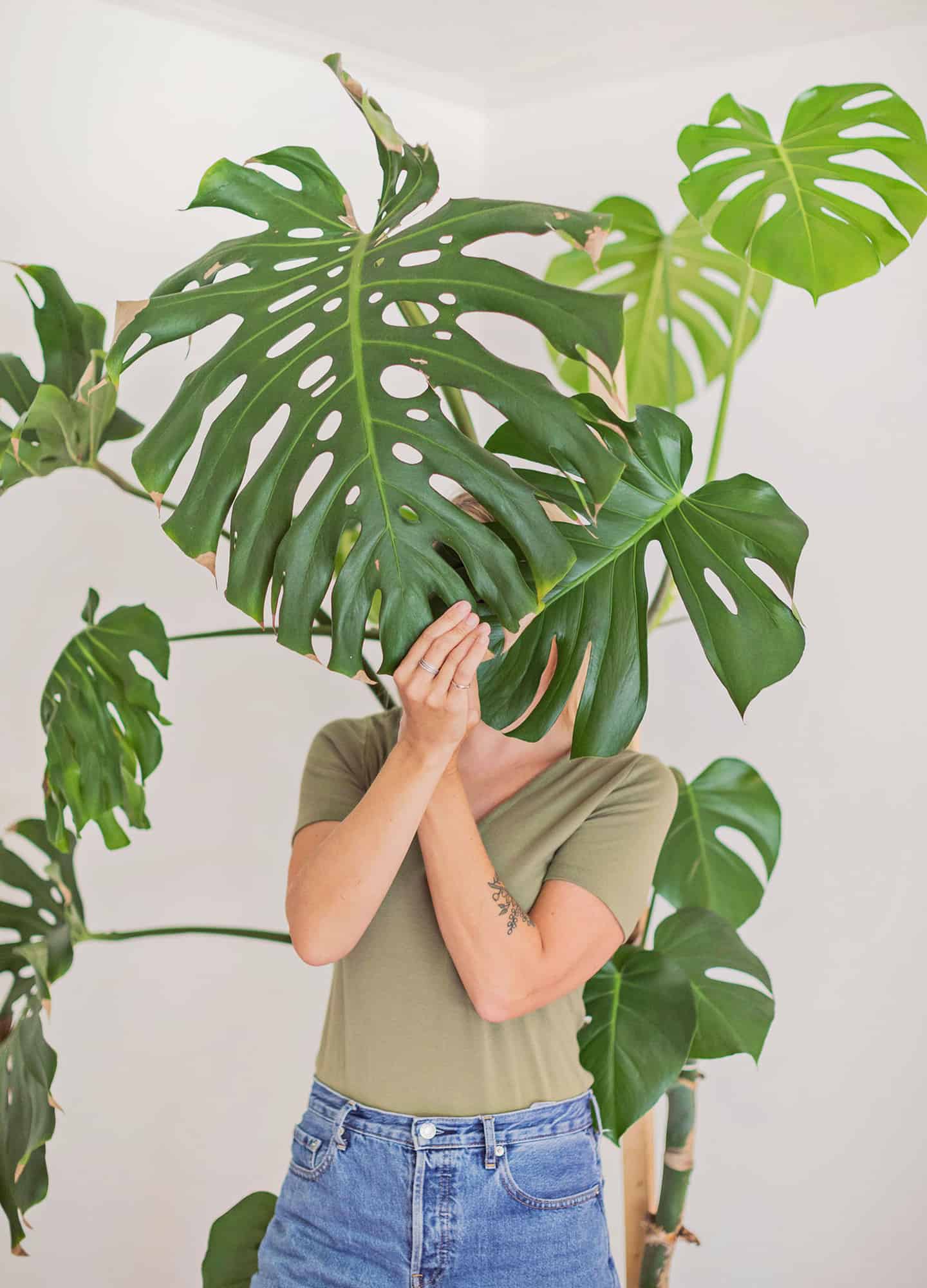 About a year ago on a warm September day, I received a text from my dear friend, Emma (you may have heard of her?), asking if I was interested in taking on care and ownership of one of her several houseplants. A picture of the largest Monstera Deliciosa I’d ever seen accompanied the text that read: “Would you have any interest in taking this split leaf? I’ve had her a couple of years but lately she’s been losing leaves and I am just worried my home isn’t working for her … She’s very large, as you can see.” My reply was a very cool and collected “yes,” but as I reread her text and gawked at the photo, I realized that all my plant dreams had come true! Sure, I was the owner of a trendy fiddle leaf. Sure, I owned a small-ish Monstera already. But this? This was a Monstera the size of a TREE! I simultaneously felt thrilled I got to be the lucky one to rehab it, and extremely anxious I wouldn’t be able to bring it back to life. And thus started my journey of taking care of the glorious Monstera Deliciosa I now lovingly call Fran.
About a year ago on a warm September day, I received a text from my dear friend, Emma (you may have heard of her?), asking if I was interested in taking on care and ownership of one of her several houseplants. A picture of the largest Monstera Deliciosa I’d ever seen accompanied the text that read: “Would you have any interest in taking this split leaf? I’ve had her a couple of years but lately she’s been losing leaves and I am just worried my home isn’t working for her … She’s very large, as you can see.” My reply was a very cool and collected “yes,” but as I reread her text and gawked at the photo, I realized that all my plant dreams had come true! Sure, I was the owner of a trendy fiddle leaf. Sure, I owned a small-ish Monstera already. But this? This was a Monstera the size of a TREE! I simultaneously felt thrilled I got to be the lucky one to rehab it, and extremely anxious I wouldn’t be able to bring it back to life. And thus started my journey of taking care of the glorious Monstera Deliciosa I now lovingly call Fran.
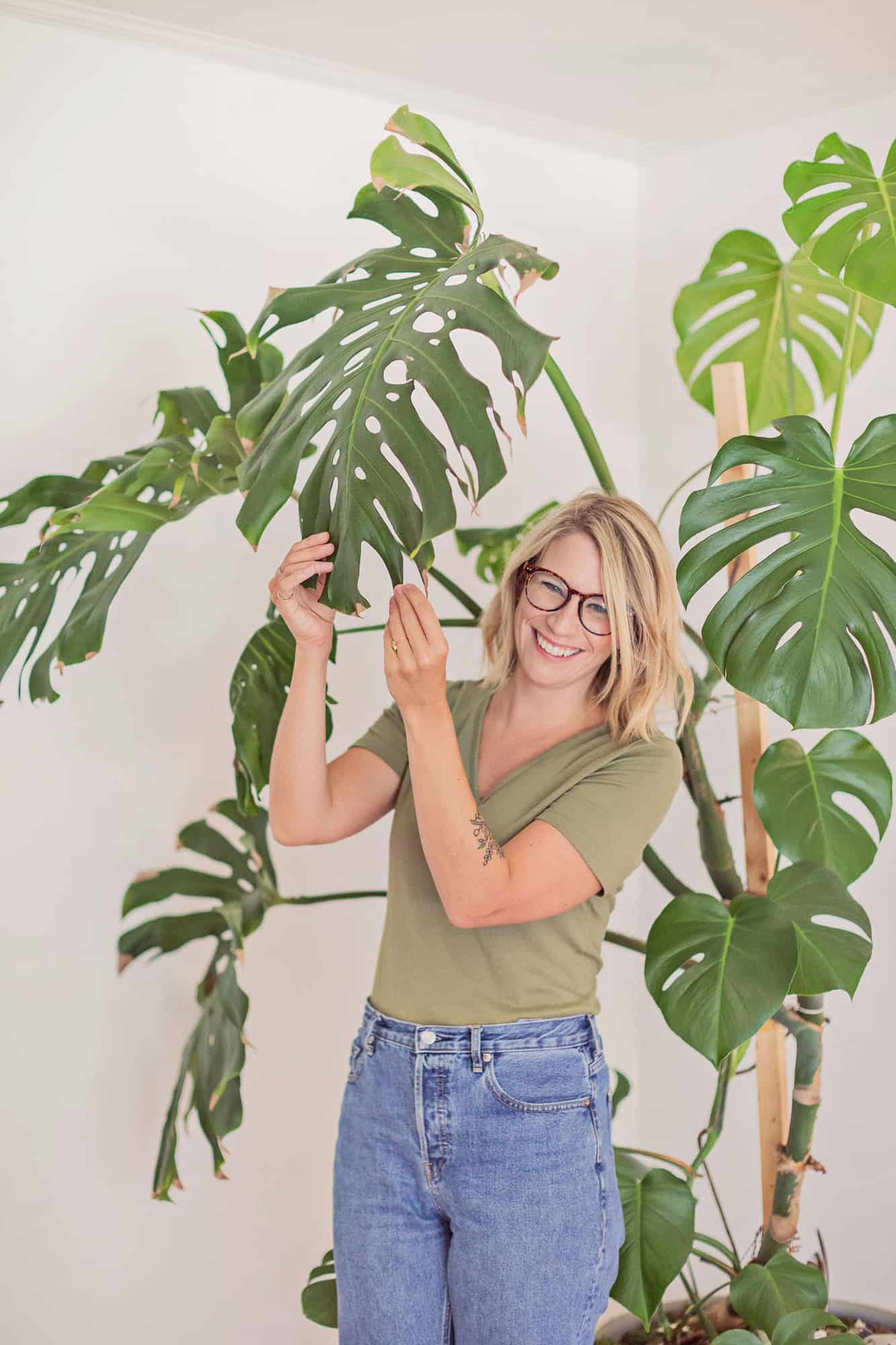
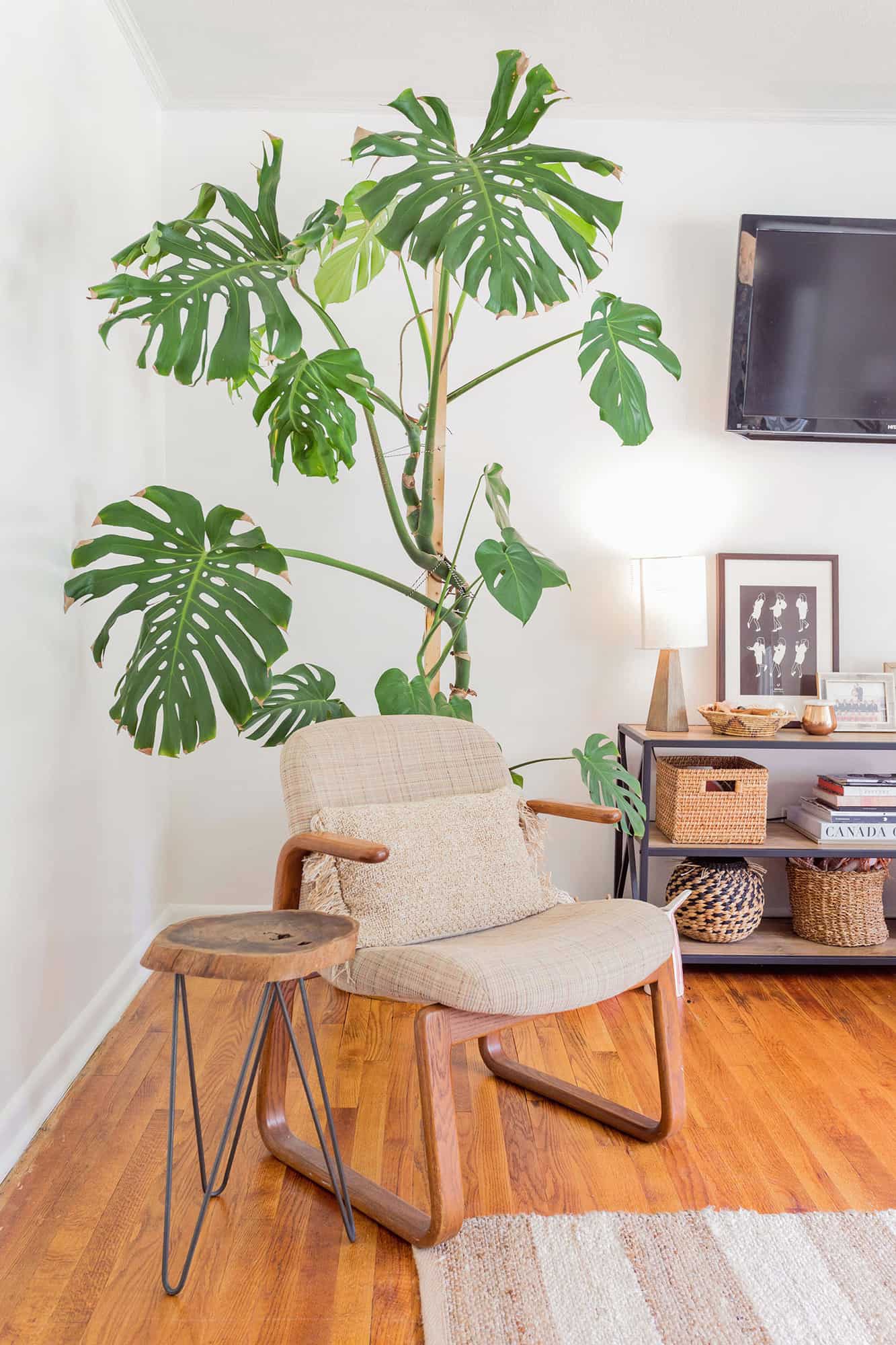 As soon as I got Fran safely home (this was no small feat!), I knew I needed to diagnose the problem Emma was experiencing so I could try to get her growing again. She was very tall, but only had four leaves on her, and almost all of them were wilted and curled. Emma told me that she hadn’t been watering the plant much in the last few months because she was afraid she had previously overwatered it, and she was concerned as well that she had placed it in a spot with inadequate light. After taking in these facts, checking Fran over, and doing a bit of research, I quickly diagnosed the problem as under watering. When a Monstera plant’s soil is dry to the touch (Fran’s was), and their leaves curl and turn brown and crispy on the ends, it means the plant hasn’t been getting enough water. In overwatering situations, the leaves turn yellow with possible blackish stems. Fran had no yellowing leaves, no blackish stems, but had very curled leaves and three of the four were brown at the ends.
As soon as I got Fran safely home (this was no small feat!), I knew I needed to diagnose the problem Emma was experiencing so I could try to get her growing again. She was very tall, but only had four leaves on her, and almost all of them were wilted and curled. Emma told me that she hadn’t been watering the plant much in the last few months because she was afraid she had previously overwatered it, and she was concerned as well that she had placed it in a spot with inadequate light. After taking in these facts, checking Fran over, and doing a bit of research, I quickly diagnosed the problem as under watering. When a Monstera plant’s soil is dry to the touch (Fran’s was), and their leaves curl and turn brown and crispy on the ends, it means the plant hasn’t been getting enough water. In overwatering situations, the leaves turn yellow with possible blackish stems. Fran had no yellowing leaves, no blackish stems, but had very curled leaves and three of the four were brown at the ends.
I learned a lot since Fran came to live with me, and am happy to report she is thriving and has sprung a total of seven new leaves in a little less than a year! Because Monsteras are so popular right now (and they should be—they are gorgeous!), it seems like my knowledge is useful and should be passed on! Whether you’re the owner of a new Monstera Deliciosa, or you’re a seasoned plant-mama (or papa!) just looking to gain some knowledge, these tips may help you maintain your lovely Monstera and possibly solve any problems you come across while taking care of it.
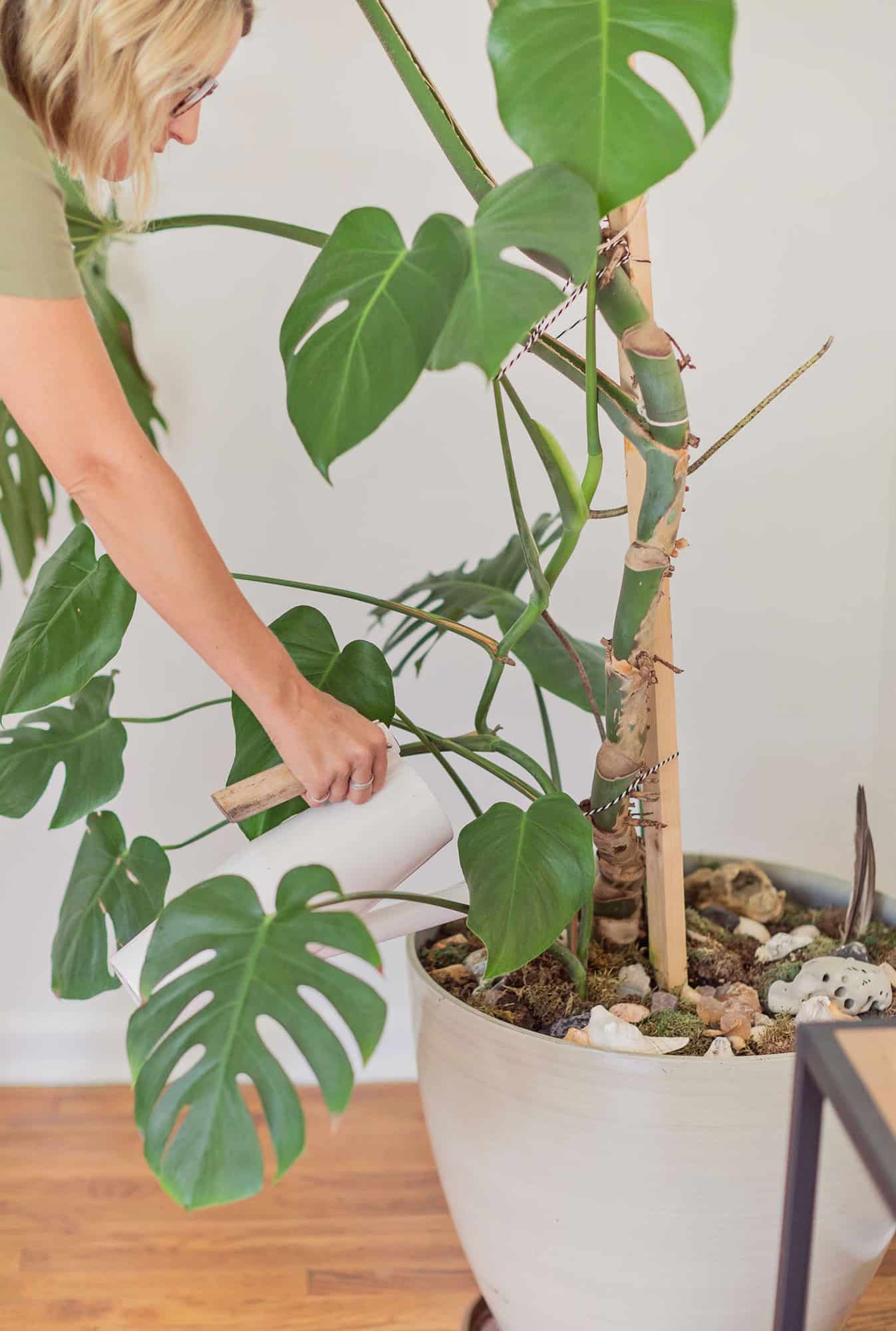 Monsteras are actually pretty easy to take care of (sorry, Emma)! They reign from southern Mexico and Panama, and because of the holes they create as they mature, they are often referred to as Philodendron Split Leaf or the Swiss Cheese Plant. I read somewhere that the holes are a byproduct of originating in the rainforest, where vegetation above blocks sunlight, so the holes are to allow sunlight to get to the bottom leaves as well as the top. I can’t remember where I read that and haven’t found that information since, but it’s kind of nice to think of the Monstera as a very pretty houseguest who knows how to share.
Monsteras are actually pretty easy to take care of (sorry, Emma)! They reign from southern Mexico and Panama, and because of the holes they create as they mature, they are often referred to as Philodendron Split Leaf or the Swiss Cheese Plant. I read somewhere that the holes are a byproduct of originating in the rainforest, where vegetation above blocks sunlight, so the holes are to allow sunlight to get to the bottom leaves as well as the top. I can’t remember where I read that and haven’t found that information since, but it’s kind of nice to think of the Monstera as a very pretty houseguest who knows how to share.
My first tip on taking care of your Monstera is regular watering. Monsteras prefer slightly moist soil and generally like to dry out just a bit between waterings. They are epiphytes with aerial roots (a plant that grows on another plant in its natural habitat), so they don’t tolerate soggy soil. For a rule of thumb, once the top 2 to 4 inches of the soil are dry, your Monstera could use some watering. Since Fran is in a large pot, I give her quite a bit of water once a week in the growing season, which is spring through early fall, and then I taper off quite a bit in the winter.
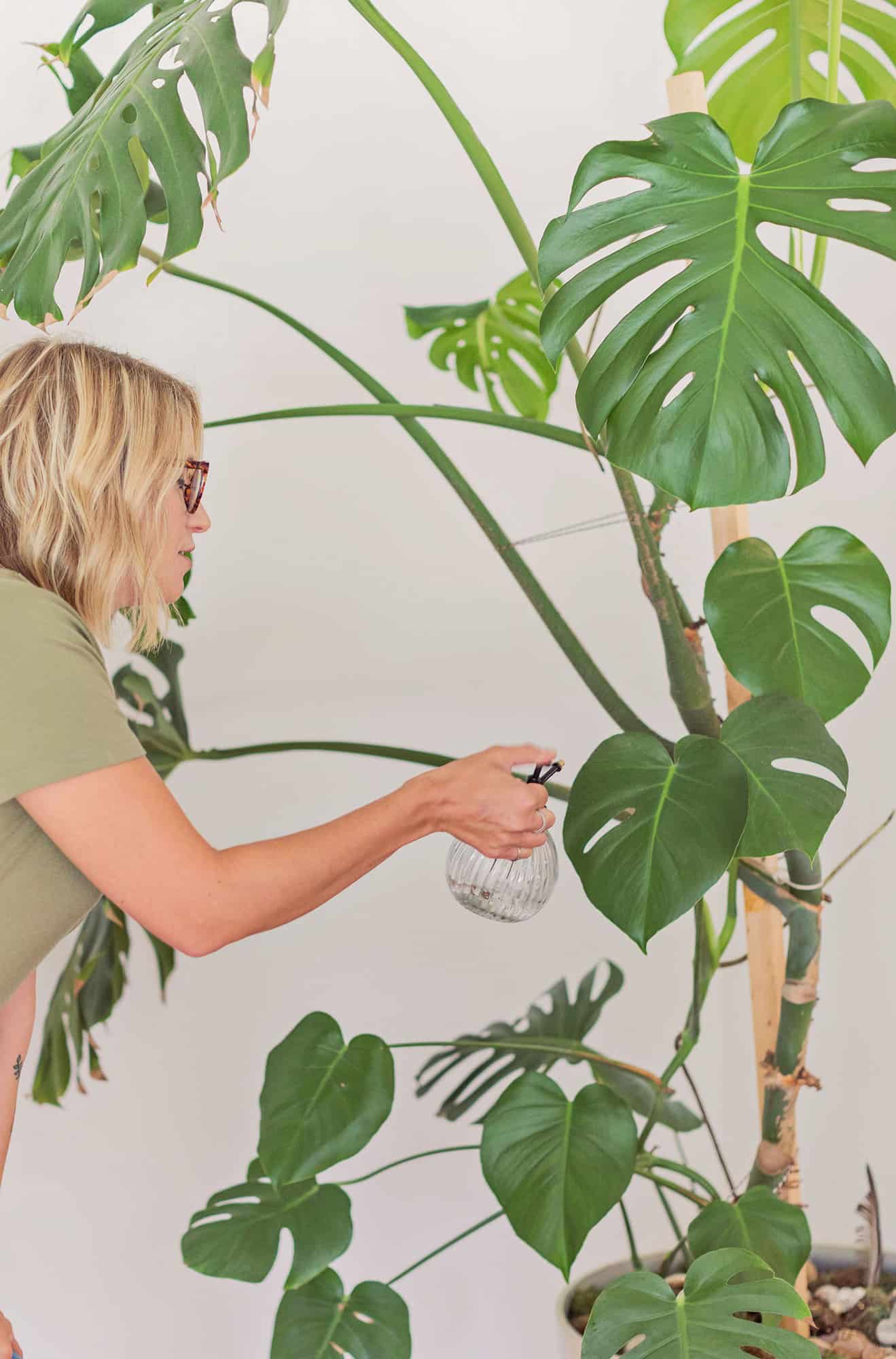 As most plant parents know, it can be difficult to diagnose an over-watering or under-watering situation when the plant shows signs of stress, so watering on a schedule is my number one tip for all house plant care in general. A long time ago, I decided I would regularly water all of my houseplants once a week, choosing Saturday as the day I’d remember to do it most consistently, and I have stuck to that plan for many years. I adjust the amount of water I give each plant based on what the soil feels like when I check it, as well as the type of plant itself, knowing some plants like more water, some like less. If the soil feels soggy at all, I skip watering that week. By planning to water every plant in the house weekly, I never forget about one, and have some dedicated time each week to check them for signs of stress or pests, dust them off, or prune them if needed.
As most plant parents know, it can be difficult to diagnose an over-watering or under-watering situation when the plant shows signs of stress, so watering on a schedule is my number one tip for all house plant care in general. A long time ago, I decided I would regularly water all of my houseplants once a week, choosing Saturday as the day I’d remember to do it most consistently, and I have stuck to that plan for many years. I adjust the amount of water I give each plant based on what the soil feels like when I check it, as well as the type of plant itself, knowing some plants like more water, some like less. If the soil feels soggy at all, I skip watering that week. By planning to water every plant in the house weekly, I never forget about one, and have some dedicated time each week to check them for signs of stress or pests, dust them off, or prune them if needed.
My second tip on Monstera care is fertilization. Fertilizers can be tricky, so once I found one I could use on all of my house plants, I bought a giant bottle and that was that. The fertilizer I use is one that I add to my water, so I fertilize once a month in the growing season at the beginning of each month with Superthrive. It is a bit pricey, but in my experience it has helped my plants stay healthy and fed better than any other fertilizer I have come across. I swear by it!
 Third, Monsteras like bright indirect light. They can adjust to medium light, but might get leggy in that environment. Before Fran came to live with me, Emma had her in a spot that didn’t get a great amount of light, so when I brought her home I placed her in a room that has large west-facing windows. The windows are all the way on the other side of the room from where Fran sits, but the room gets enough light in the afternoons and evenings that she seems to love it in that spot. (In fact, all my plants love that room, no matter where they sit). She never gets direct beams of light so her leaves don’t burn, which is important to consider when choosing a spot for a Monstera, and she gets to show off as the largest in a room filled with plants.
Third, Monsteras like bright indirect light. They can adjust to medium light, but might get leggy in that environment. Before Fran came to live with me, Emma had her in a spot that didn’t get a great amount of light, so when I brought her home I placed her in a room that has large west-facing windows. The windows are all the way on the other side of the room from where Fran sits, but the room gets enough light in the afternoons and evenings that she seems to love it in that spot. (In fact, all my plants love that room, no matter where they sit). She never gets direct beams of light so her leaves don’t burn, which is important to consider when choosing a spot for a Monstera, and she gets to show off as the largest in a room filled with plants.

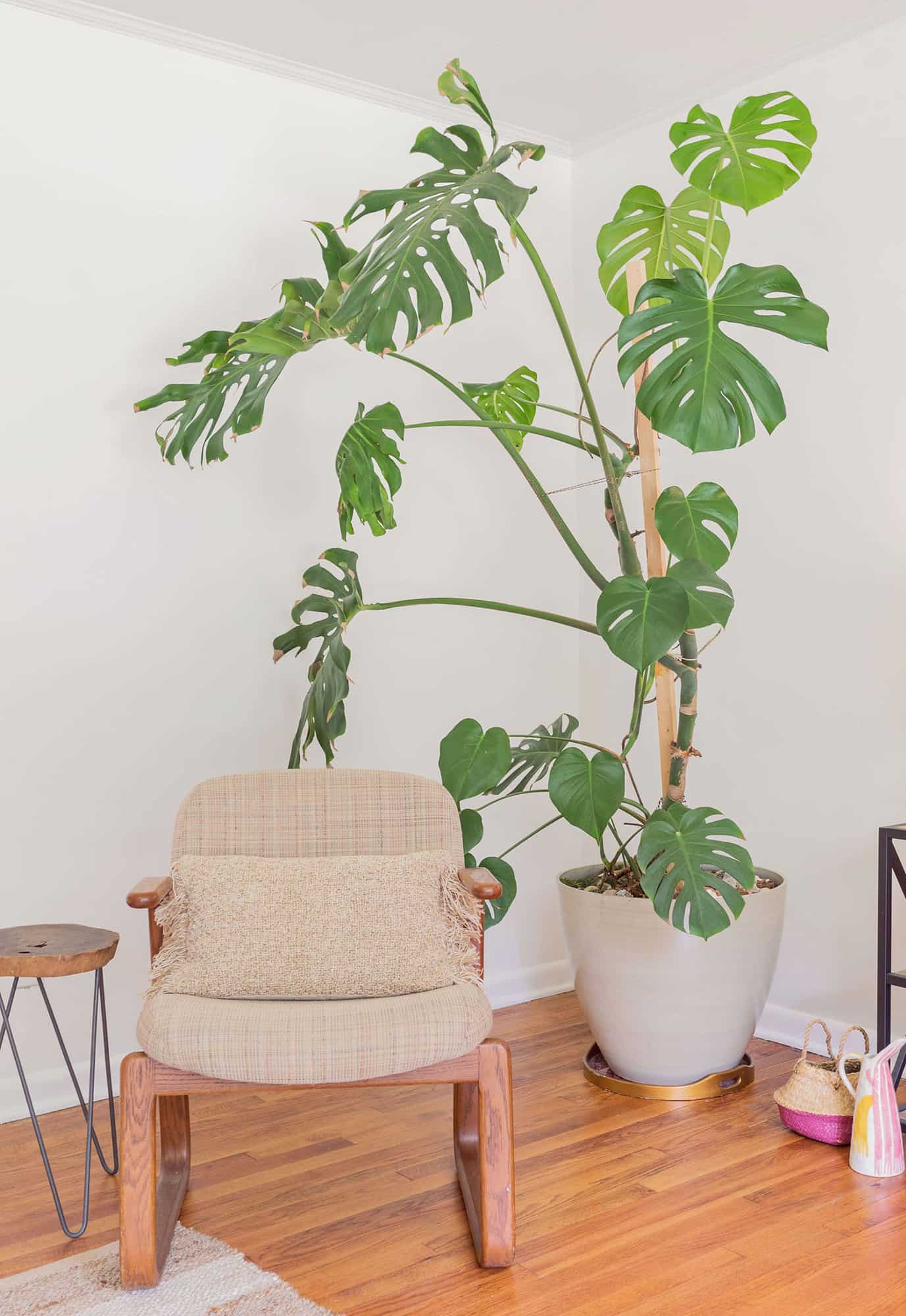 My next tip on taking care of a Monstera is staking! In the wild, Monsteras climb up on other trees as they grow, and can grow up to 66 feet tall! Inside they can only get to about 9 feet tall, and will use a stake (preferably covered in moss but mine is not) as their inside host. I learned the hard way that staking is a must for Monsteras through taking care of another smaller, but bushier one I have in a different room. For a long time it wasn’t staked, until one day as I was dusting the leaves, I knocked the whole thing over onto the desk below where it perched, and sadly, many stems tore off the main plant. I was able to propagate some of those stems, thank goodness, but I learned my lesson. Stakes help the plant grow upward and can really help keep all those big leaves balanced. A little side note: I actually planted some of the stems I propagated alongside Fran in her pot! I figured there was enough space and Fran could use a little company, and the addition made Fran’s bottom half more proportional with her giant top half. She does have some new smaller leaves off a node at the bottom of her trunk, but the rest of the leaves are from a different Monstera.
My next tip on taking care of a Monstera is staking! In the wild, Monsteras climb up on other trees as they grow, and can grow up to 66 feet tall! Inside they can only get to about 9 feet tall, and will use a stake (preferably covered in moss but mine is not) as their inside host. I learned the hard way that staking is a must for Monsteras through taking care of another smaller, but bushier one I have in a different room. For a long time it wasn’t staked, until one day as I was dusting the leaves, I knocked the whole thing over onto the desk below where it perched, and sadly, many stems tore off the main plant. I was able to propagate some of those stems, thank goodness, but I learned my lesson. Stakes help the plant grow upward and can really help keep all those big leaves balanced. A little side note: I actually planted some of the stems I propagated alongside Fran in her pot! I figured there was enough space and Fran could use a little company, and the addition made Fran’s bottom half more proportional with her giant top half. She does have some new smaller leaves off a node at the bottom of her trunk, but the rest of the leaves are from a different Monstera.
My last and final tip is a little odd and may come across as “woo-woo” to some, but I kind of believe in going above and beyond to add a little love to my plants, and Fran is no exception. Not only did I name her and give her the best seat in my house, but I placed moss on the top of her soil as well as various rocks and seashells I have found on some of my travels throughout the years. Collecting rocks and shells has always been a “thing” for me, but I find placing them on top of my plants’ soil sends a little extra boost of love to the plant, (or at least it does in my head), and it makes the plant look even prettier and adds a special touch!
That’s it for my tricks on how I got Fran to go from Sad-but-Giant-Monstera to Gorgeous-OMG-knock-my-socks-off-Giant-Monstera! I hope you find something useful in all that I’ve learned in taking care of her! Feel free to add any tips or tricks you know of in taking care of Monsteras in the comments! -Michelle
Credits // Author: Michelle Houghton. Photography: Janae Hardy. Photos edited with A Color Story Desktop.
from A Beautiful Mess https://ift.tt/3lRYQFN
via IFTTT